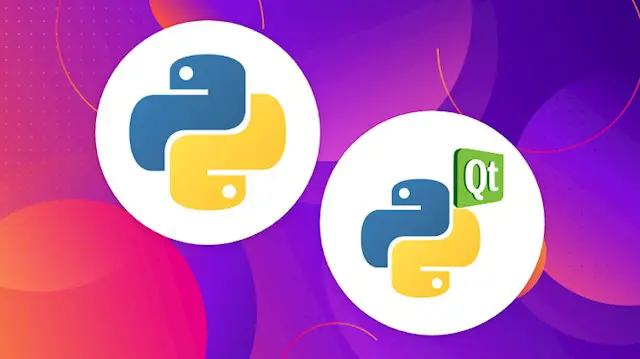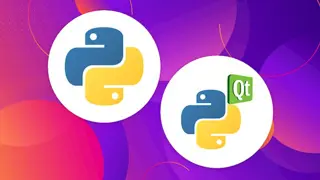- Reed courses certificate of completion - Free

Python Gui Development with Tkinter Python and Python PyQt5
Oak Academy
Python Tkinter & Python Gui with PyQt5, boost your tkinter and pyqt5 skills to build gui desktop application development
Summary
Overview
Certificates
Reed courses certificate of completion
Digital certificate - Included
Will be downloadable when all lectures have been completed
Curriculum
-
Course Intro 00:59
-
Course Overview - Python Gui Development with Tkinter Python and Python PyQt5 07:48
-
Python Setup 52:44
-
Variables 09:36
-
Numbers 11:20
-
Strings 13:29
-
Conditionals 39:57
-
Loops 27:23
-
Functions 19:02
-
Modules 16:33
-
Lists 19:09
-
Tuples 07:43
-
Dictionaries 18:59
-
Exceptions 18:46
-
Files 26:24
-
Sets 18:08
-
OOP 35:06
-
Project 21:36
-
Python Tkinter 12:15
-
Components 1:00:54
-
Layout Management 33:11
-
Geometry Manager 31:02
-
Customization 50:30
-
Examples 29:50
-
Styles and Themes 08:41
-
Examples 1:26:06
-
Fundamentals of Matplotlib 56:53
-
Project Overview 02:15
-
Create the User Interface 39:35
-
Let's start to Coding our Program 2:49:03
-
Extra 01:00
Course media
Description
Tkinter, Python Gui, tkinter python, python tkinter, gui, Python GUI, desktop application development, desktop application, python gui programming, pyqt, pyqt5 , python pyqt5
Hello there,
Welcome to the " Python Gui Development with Tkinter Python and Python PyQt5 " course.
Python Tkinter & Python Gui - Boost your Tkinter Python skills with hands- on python gui programming desktop application.
Python is a general-purpose, object-oriented, high-level programming language. Whether you work in artificial intelligence or finance or are pursuing a career in web development or data science, Python is one of the most important skills you can learn.
Tkinter is a Python binding to the Tk GUI toolkit. It is the standard Python interface to the Tk GUI toolkit and is Python's de-facto standard GUI. Tkinter is included with standard GNU/Linux, Microsoft Windows and macOS installs of Python. The name Tkinter comes from the Tk interface
Tkinter is the de facto way in Python to Graphical User interfaces (GUIs) and is included in all standard Python Distributions. Python has a lot of GUI frameworks, but Tkinter is the only framework that's built into the Python standard library. In fact, it's the only framework built into the Python standard library.
Tkinter is the standard GUI library for Python. Python when combined with Tkinter provides a fast and easy way to create GUI applications. Tkinter provides a powerful object-oriented interface to the Tk GUI toolkit.
The GUI (graphical user interface) is a form of user interface that allows users to interact with electronic devices through graphical icons and audio indicator such as primary notation, instead of text-based UIs, typed command labels or text navigation.
PyQt is a Python binding of the cross-platform GUI toolkit Qt, implemented as a Python plug-in. PyQt is free software developed by the British firm Riverbank Computing.
In this course, we will learn what is the GUI, and Tkinter and how they work. And also how we create a program with GUI in python. For those who want to use Python not only in AI and Data Science, but also to develop a program using Python.
Also in this course, we will learn what is the GUI, PyQT5 and how does it work. And also how we develop a program with python. For those who want to use Python not only in Artificial Intelligence ( AI ) and Data Science or Machine Learning but also develop a program using Python.
And in this course, We will open the door of the Python world and try to move deeper. We will learn fundamental things about Python, step by step. Throughout the course, we will do a variety of exercises to reinforce what we have learned.
Creating a GUI application using Tkinter is an easy task. All you need to do is perform the following steps −
-
Import the Tkinter module.
-
Create the GUI application main window.
-
Add one or more of the above-mentioned widgets to the GUI application.
-
Enter the main event loop to take action against each event triggered by the user.
Why would you want to take this course?
Our answer is simple: The quality of teaching.
When you enroll, you will feel the OAK Academy`s seasoned developers' expertise.
Video and Audio Production Quality
All our videos are created/produced as high-quality video and audio to provide you the best learning experience.
You will be,
-
Seeing clearly
-
Hearing clearly
-
Moving through the course without distractions
You'll also get:
Lifetime Access to The Course
Fast & Friendly Support in the Q&A section
Dive in now!
We offer full support, answering any questions.
See you in the "Python Gui Development with Tkinter Python and Python PyQt5 " course.
Python Tkinter & Python Gui - Boost your Tkinter Python skills with hands- on python gui programming desktop application.
Who is this course for?
- Those who want to master Python TkInter skills to build desktop application skill.
- Anyone who is interested in Python, Python Gui, Python Tkinter.
- Anyone who has programming experience and wants to enter the python world. In this world your journey never ends. You can develop yourself at data science or Machine learning and even developing an application.
- Statisticians and mathematicians who want to learn python for machine learning and deep learning.
- Tech geeks who curious with Machine Learning and Deep Learning concept.
- Data analysts who want to learn machine learning and deep learning and data visualization.
- And also, who want to learn how to develop a GUI with Python very easily.
- Any developer or engineer who wants to crack programming interviews
- If you are one of these, you are in the right place. But please don't forget. You must know a little bit of coding and scripting.
- Students who want to learn about python gui, pyqt deeply
Requirements
- Desire to learn about Tkinter Python, Python Gui, Python
- You'll need a desktop computer (Windows, Mac) capable of running Anaconda 3 or newer. We will show you how to install the necessary free software.
- A little bit of coding experience
- At least high school level math skills will be required.
- Watch the course videos completely and in order
- Learning determination and patience.
- Curiosity for python gui programming using pyqt5
- Desire to learn Python GUI
- Desire to learn python pyqt, pyqt5
- LIFETIME ACCESS, course updates, new content, anytime, anywhere, on any device
Questions and answers
Currently there are no Q&As for this course. Be the first to ask a question.
Reviews
Currently there are no reviews for this course. Be the first to leave a review.
Sidebar navigation
Legal information
This course is advertised on Reed.co.uk by the Course Provider, whose terms and conditions apply. Purchases are made directly from the Course Provider, and as such, content and materials are supplied by the Course Provider directly. Reed is acting as agent and not reseller in relation to this course. Reed's only responsibility is to facilitate your payment for the course. It is your responsibility to review and agree to the Course Provider's terms and conditions and satisfy yourself as to the suitability of the course you intend to purchase. Reed will not have any responsibility for the content of the course and/or associated materials.
FAQs
Interest free credit agreements provided by Zopa Bank Limited trading as DivideBuy are not regulated by the Financial Conduct Authority and do not fall under the jurisdiction of the Financial Ombudsman Service. Zopa Bank Limited trading as DivideBuy is authorised by the Prudential Regulation Authority and regulated by the Financial Conduct Authority and the Prudential Regulation Authority, and entered on the Financial Services Register (800542). Zopa Bank Limited (10627575) is incorporated in England & Wales and has its registered office at: 1st Floor, Cottons Centre, Tooley Street, London, SE1 2QG. VAT Number 281765280. DivideBuy's trading address is First Floor, Brunswick Court, Brunswick Street, Newcastle-under-Lyme, ST5 1HH. © Zopa Bank Limited 2026. All rights reserved.


